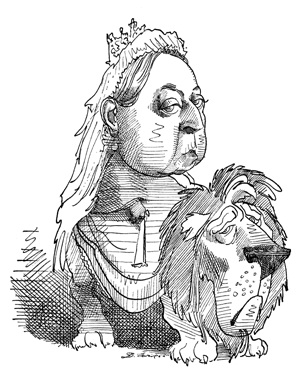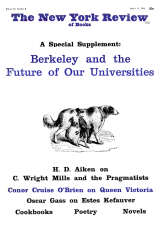Very few biographies which have reached the public in recent years can have as good a claim to be called “definitive” as has Elizabeth Longford’s life of Queen Victoria, and this for several reasons. A biography, to be regarded as definitive, must be based on plentiful materials and very few lives could have been so abundantly documented as that of Queen Victoria. The Queen was an object of intense interest to herself and knew herself to be also of intense interest to her family, her subjects, her contemporaries, and posterity. Like so many of her contemporaries she loved writing as a form of activity and her letters and journals—the main sources of this biography—constitute an extraordinarily full record of her views, her actions and above all her feelings from day to day. The spontaneity of her writing is unmistakable; although she was consciously writing for posterity as well as for the day, she was so confident that posterity would agree with her about everything that this consideration did not inhibit her as it has inhibited other diarists. Other biographers—notably Lytton Strachey—have of course made use of much of this material, but Lady Longford seems to be the first to have been granted full access to all that is now preserved. As she says “a complete portrait of Queen Victoria was never possible without recourse to the copious material in the royal archives at Windsor Castle. By gracious permission of Her Majesty the Queen I have been given unhindered access to all the relevant papers.”
A less skillful biographer might well have been swamped—as the biographers of so many Victorian worthies were in fact swamped—by the sheer volume of the source material. Lady Longford, however, remains in firm control of this material throughout her long but nicely balanced and never tedious narrative. The secret of her success in this is not, I think, solely or even mainly her craftsmanship as a writer, considerable though that is, but above all her sustained interest in, and sympathy with, her subject. It is not primarily the official figure of the Queen which interests her but the daughter, the wife, the mother, the widow—and all these capabilities and predicaments heightened and illuminated by the special light of royalty. She likes Queen Victoria and although she is not likely to succeed in transmitting this affection in its entirety to all her readers, I can at least testify—as one who had previously found Queen Victoria extremely unsympathetic—that she does succeed in making one like her a little better than one did. Here her success comes from a certain alertness in her affection and from the fact that she never falls victim to any of the obvious forms of sentimentality. She is quite aware, for example, of that streak of hardness even vindictiveness, in the Queen’s character which showed itself in her dealings with her mother after her accession, in her shocking treatment of Lady Flora Hastings, and in her insistence on the adequate punishment of civil and military malefactors. Lady Longford does not try to soften these traits; her Victoria is in many ways the hard representative of a hard age, but side by side with the hardness, and sometimes strangely combining with it, we find evidence of a kind of generosity in which the Queen probably excelled most of her subjects. It is clear that she did genuinely dislike, and not just formally deplore, religious intolerance, anti-Semitism, and the color bar. One of the rare cases in which her personal influence was felt in politics was when she exerted herself to counteract the wave of vindictiveness against India and Indians which swept over England in the wake of the Indian Mutiny atrocities. One need only think of contemporary Western reactions to considerably less bloody news from Africa to realize how exceptional in her time the Queen’s magnanimity on this occasion was. It is true that her good feeling towards India was connected with an incorrigible romanticism about the Orient—a romanticism which eventually included Disraeli—and that where occidental and unromantic people like the Irish were concerned she was, in practice, callous enough. She instituted bread rationing in Buckingham Palace (one pound a day) as a kind of salute to the Irish Famine, but she never attempted in any way to offset or protest against the lethal process of systematic government negligence, described by Cecil Woodham Smith in The Great Hunger, which led in the space of a few years to the death by starvation of a million of her subjects and the emigration of another million in appalling conditions. But her attitude to the Irish famine was not more or less than perfectly representative of the ruling class of which she was the symbolic head.
Advertisement
In this, as in much else, Lord Melbourne had been her mentor and had humorously discouraged her early tendency to soft-heartedness, or what Lady Longford calls her “inherited effusiveness”: “At seventeen Victoria had studied Irish history with Lehzen: How ill treated that poor Country & Nation has been! she exclaimed in her Journal. When, as Queen, she asked Melbourne what happened to the ‘poor Irish’ who were evicted by their landlords, Melbourne replied, ‘They become absorbed somehow or other’—which made them all laugh amazingly. He added that ‘they ate too much and there was not enough for them and you.” There was nothing exceptional in Melbourne’s attitude, only in the lack of hypocrisy with which he was in the habit of expressing himself. His political tuition of the young Queen was an excellent and charmingly delivered course in the values of the class which she had been crowned to serve. Certainly there was—and there was intended to be—something dehumanizing about the whole process, a flavor of subtle corruption, in the manner of Henry James. Lady Longford herself is made uneasy: “she paid a high price for her glimpse into Melbourne’s cool world.” Edith Sitwell put it more hotly: “There are times when I see dear, good, kind, whimsical Lord M. wearing a devil’s mask and bearing a devil’s grin.” Yet one feels that what such critics resent about Lord M. is precisely that he did not wear a mask and did not hide his grin. The breezy way in which he imbued Victoria with so many of the real, as distinct from the formal, values of his class and time may well have damaged her as a person, but constituted a very good practical training for her as the kind of Queen she was intended to be. She remained in some ways exceptional—as in her sympathies with the non-white peoples—but she was enough Lord Melbourne’s pupil to make a satisfactory Queen of England.
There is another reason why this biography is likely to be definitive: that is that Lady Longford, with much art and tact, has “done” the human interest side of Queen Victoria’s life so well that no one else is likely to try it again, and that the political side of the life is simply not important enough for anyone to be able to do much with it. For the truth is that while the existence of the Monarchy was a fact of major political importance, the Queen herself had only a very slight and marginal importance which she and others consistently and sincerely exaggerated. She had a certain nuisance value for political in-fighting, and the Tories in particular were able to make some fairly effective use of her hostility to Gladstone, as in the case of the dreadful fuss that she made over General Gordon. But her feelings about Gladstone did not, and could not, prevent that statesman from becoming four times Prime Minister of England during her reign. It is true that in her last years she became a sort of cult-object of the new imperialism, and that she liked this, but it does not seem that she deserves either praise or blame for the development of these phenomena. Sir Sydney Lee, in his semi-official biography, published just after her death, discreetly indicated that the old lady owed a good deal more to imperialism than it owed to her:—“She and her ministers in her last years encouraged the identification of the British sovereignty with the unifying spirit of imperialism, and she thoroughly reciprocated the warmth of feeling for herself and her office which that spirit engendered in her people at home and abroad. But it is doubtful if, in the absence of the imperial idea, for the creation of which she was not responsible, she could under the constitution have enjoyed that popular regard and veneration of which she died in unchallenged possession.”
The most that can be argued is that her long reign, and the coroneted Mrs. Dale’s Diary of her family life, preserved, and eventually strengthened, the institution of monarchy which her Hanoverian predecessors had so gravely weakened. Even this seems to me very doubtful. The survival of the monarchy had much more to do with the interest and policy of the ruling class than with the personality of the monarch and there seems no reason to suppose that the aristocracy and upper middle class of England would, even if faced with a continued run of profligate and unsuitable monarchs, have scrapped the institution. It is much more likely that their representative leaders, if a particular monarch had proved a serious liability and utterly failed to discharge those “visible” political functions identified by Bagehot, would have obtained the departure of the monarch who failed to give satisfaction. They had, after all, done so before by deposition and were to do so again by enforced abdication. Indeed the abdication of Queen Victoria herself was seriously discussed when, after Albert’s death, she failed to give adequate attention to the job for which she was employed. She does not seem, in fact, to have been popular with her subjects throughout most of her reign, and the popularity of her last years went to a sort of stage-prop trundled around in Jubilees rather than to the contradictory and curious human being described in Lady Longford’s biography. Certainly in the publicities of jingoism the Queen’s longevity and respectability could be, and were, turned into assets, but so could other widely different combinations of human qualities have been. Honored age was good, but youth and beauty would have been even better. Even without any of these qualities—without youth, or great age, or beauty, or intelligence, or virtue or personal charm—the Queen’s successor, Edward VII, proved a successful and popular monarch. It is not mainly the character of a monarch but the fairy-tale element, the sheer infantile appeal in the institution of monarchy itself, that has the power to move. We feel its sinister magic not only in Lady Longford’s prose but also in her well-chosen illustrations—notably that famous one in which the young Queen, in her nightgown, “shoots out her little paw” to be kissed by the Lord Chamberlain, bringing the news of her accession. The power of such an image, and of the “divinity that doth hedge” in general, is extraordinary and tenacious. The political significance of these ancient illusions is that they generate other illusions, concealing the nature of society and inducing a drugged acquiescence. I greatly fear that Lady Longford’s attractive book will have the effect of strengthening the costly charisma of the British monarchy. In giving her “unhindered access to all the relevant papers” Her Majesty the Queen was well advised.
Advertisement
This Issue
March 11, 1965




